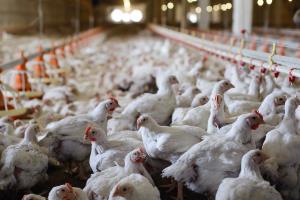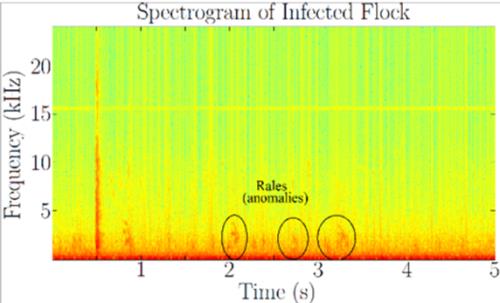 A recent virtual presentation at an industry conference by Tom Darbonne and Dr. David Anderson of Georgia Tech demonstrated the potential for audio monitoring of flocks to obtain an early indication of non-clinically apparent disease or equipment malfunction. The principle was developed by Dr. Anderson and has been the subject of research by Georgia Tech for a number of years. Initial research was supported by the State of Georgia and the Agricultural Technology Research Program at Georgia Tech. and with the cooperation of the Georgia Poultry Federation and integrators. More recent studies have been funded by the Foundation for Food and Agricultural Research supported by McDonald's Corporation, Tyson Foods and other agribusiness companies.
A recent virtual presentation at an industry conference by Tom Darbonne and Dr. David Anderson of Georgia Tech demonstrated the potential for audio monitoring of flocks to obtain an early indication of non-clinically apparent disease or equipment malfunction. The principle was developed by Dr. Anderson and has been the subject of research by Georgia Tech for a number of years. Initial research was supported by the State of Georgia and the Agricultural Technology Research Program at Georgia Tech. and with the cooperation of the Georgia Poultry Federation and integrators. More recent studies have been funded by the Foundation for Food and Agricultural Research supported by McDonald's Corporation, Tyson Foods and other agribusiness companies.
The intent of the technology is to monitor sounds generated by a flock and to provide an early warning of the presence of either disease or an environmental factor that could stress or disturb flocks. Most trained clinicians can discern respiratory rales (‘snicks’) associated with either a post-vaccine reaction or the early stages of a respiratory disease such as ILT, MG or IB. To gain an appreciation of abnormal sounds it is necessary to completely dim the lights and to deactivate the ventilation system in the house. Interpretation of sounds is subjective and requires instruction and experience. 
Clinicians generally correlate the presence of respiratory rales in a flock with clinical signs such as lachrymation and gasping attributed to viral respiratory infections. Moist rales (‘gurgling’) accompanied by nasal discharge and facial swelling is more likely attributed to coryza or mycoplasmosis. In early stages of END and HPAI affected and depressed flocks may be extremely quiet as is apparent in cage-housed layers. The most frequently encountered situation with obvious abnormal flock sounds involves the high-pitched chirping of chicks subjected to low temperature. In the case of a chilled flock, distribution is characterized by huddling and confirmed by surface temperature readings.
The sounds generated by a flock affected with a respiratory virus such as ILT can be depicted in a spectrogram denoting the frequency of respiratory rales. Spectrograms of healthy and affected flocks can be used to "train" systems to recognize specific deviations from normality. Applying machine learning to the analysis of sounds generated by a flock requires the electronic labeling of specific sounds. The more intense the labeling the more accurate will be the predictive model and hence the decision output.
Recognizing specific sounds made by a flock under commercial conditions is confounded by the noise of fans, operation of feeding equipment and concurrent sounds generated by the numerous unaffected chickens in a flock. To be effective the system will have to be refined to eliminate extraneous sounds.
Two development directions are currently under review. The first involves installation of acoustic sensors in individual houses to provide data that can be integrated with other parameters that can be transmitted to a remote location to be interpreted. According to Tom Darbonne acoustic monitoring may provide an indication of response to feeding, lighting schedules or equipment failure The second application is the deployment of hand-held monitors that can be used by service persons and poultry health professionals for audits and investigations.
 At some stage, the development of acoustic monitoring must generate a benefit and provide advantages over organoleptic evaluation of flocks with specific reference to characteristic sounds associated with normal activities, stress, fear, or disease. Acoustic monitoring offers an extension to current subjective but mostly efficient evaluation of health and welfare represented by the concept of stockmanship.
At some stage, the development of acoustic monitoring must generate a benefit and provide advantages over organoleptic evaluation of flocks with specific reference to characteristic sounds associated with normal activities, stress, fear, or disease. Acoustic monitoring offers an extension to current subjective but mostly efficient evaluation of health and welfare represented by the concept of stockmanship.
If the technology is cost-effective it will be adopted by a progressive industry. If acoustic monitoring proves to be technology merely for the sake of technology we will not observe any commercial application. We still have trained servicepeople and poultry health professionals with eyes, ears, noses and an appreciation of temperature. They are able to integrate sensations and process inputs to derive a logical understanding of the health and welfare status of a flock. The challenge facing acoustic monitoring will be to demonstrate superior detection of disease or mismanagement compared to current human and instrument based monitoring.